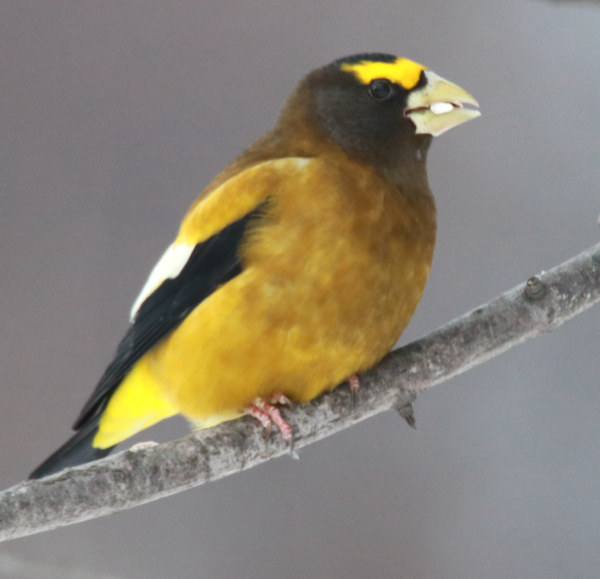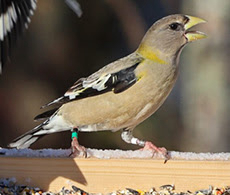
Evening Grosbeaks are large colorful songbirds that have experienced precipitous population declines during the past 50 years. Birders are helping an on-going research by reporting (photo by Paul Konrad).

A banded female Evening Grosbeak provides an example of what some colored bands may appear like if banded birds visit your feeders (photo by David Yeany).
|
An international collaboration focused on the conservation of Evening Grosbeaks, called the Road to Recovery Initiative (R2R), is tracking banded Evening Grosbeaks across their annual cycle to try to learn more about why the species has been declining in numbers – losing an estimated 92 percent of its continental population since 1970. Part of the research study includes color-banding individual Evening Grosbeaks, as well as tagging some with tiny satellite transmitters and radio transmitters to better understand their irruptive movements across seasons and geographic regions.
Collaborators have color-banded nearly 400 Evening Grosbeaks among wintering populations in Pennsylvania, New York, Maine, and Minnesota. Transmitters have also been deployed on more than 200 Evening Grosbeaks that show links to areas in Manitoba, Ontario, Quebec, Nova Scotia, and Newfoundland.
Birders who see banded Evening Grosbeaks at their feeders, evergreen trees, or fruit trees can help by reporting observations of color-banded or tagged Evening Grosbeaks. Each observation adds valuable information about the species and potentially will add insights about why this species has declined so much. If you see a banded Evening Grosbeak this winter, please report it to the US Bird Banding Lab at USGS Bird Banding Lab and email avian ecologist David Yeany at dyeany@paconserve.org
All banded Evening Grosbeaks will have an aluminum leg band, plus up to 3 colored bands. It's important to look determine the sex of the bird and record the location of each band – whether a band is positioned on the upper or lower areas of the right leg or left leg – along with each band’s color. You will also provide the date and location (the address or GPS coordinates) of the observation. Even reports of partial band combinations can be useful, and documentary photos are best! This is one of many kinds of things we birders do to provide valuable information to assist researchers and conservation biologists, as well as other birders interested in seeing these impressive songbirds.
Conservation of Evening Grosbeaks – A Road to Recovery Species Project
Evening Grosbeaks are large North American finches distributed widely across forested regions of Canada and the northern and mountain forests of the United States. The species is quite secretive during the nesting season in northern and montane coniferous forests, and has an irruptive migration strategy during the fall and winter – regularly moving in flocks in response to the availability of winter tree seeds. Evening Grosbeaks were once common, gregarious birds that frequented winter feeds in many parts of their range, but without warning the species became the fastest declining land bird in the continental United States and Canada.
This decline prompted several conservation organizations to add Evening Grosbeaks to recent conservation lists, including Partners in Flight’s “Yellow Watchlist” in 2016, the Canada Special Concern Species List in 2016, and the IUCN Red List as Vulnerable in 2018. The Evening Grosbeak is cited as the fastest declining landbird in the continental United States and Canada in the Partners in Flight 2016 Landbird Conservation Plan. Causes for the Evening Grosbeak decline are not yet fully understood, but several factors have been cited as playing a role: Fluctuations in spruce budworm populations, which are a key food source during the nesting season; the loss and alteration of mature forests, collision mortalities, disease, and the effects of climate change on northern forests.
Conservation Projects
Through the support of R2R and with funding from the Knobloch Family Foundation, researchers are expanding Evening Grosbeak conservation research. The project began in 2017 with research on winter movements of Evening Grosbeaks in Pennsylvania, which was initiated by the Pennsylvania Natural Heritage Program at the Western Pennsylvania Conservancy, the Powdermill Avian Research Center at the Carnegie Museum of Natural History, and the Finch Research Network.
Recently, the project partners created the Evening Grosbeak Working Group, an international team of ornithologists, conservation practitioners, social scientists, foresters, birders, and others – all focused on the conservation of the species within a cooperative framework. The first objectives for the working group include building a diverse team that is representative of the species’ geographic range, assessing current knowledge gaps in Evening Grosbeak ecology, and promoting conservation through birders and others through the Finch Research Network.
With humble beginnings in Pennsylvania, researchers are implementing a tracking study across the Evening Grosbeak’s continental winter range using cutting edge satellite transmitters and radio transmitters to follow individual birds throughout their annual cycle. One main goal of this effort is to better understand the limiting factors driving Evening Grosbeak declines and how they might differ across the species extensive range. By linking movements of individuals and groups of birds across non-breeding and nesting areas, researchers expect to pinpoint geographic locations of importance where both conservation actions and local community engagement might be implemented.
Similar to crossbills, Evening Grosbeaks have 5 populations that can be distinguished by their call types across the species’ wide range, and each population could exhibit different migratory connectivity and require different conservation strategies based on varying limiting factors and threats. As the tracking study progresses, researchers intend to focus on the 5 populations across the continent, beginning in the Northeast and Midwest regions and followed by studies of Western populations to gain a more complete picture of Evening Grosbeaks’ range-wide annual cycle, ecology, and population declines.
Now, birders are helping to provide valuable information they collect when they see color-banded birds at their feeders, in their yards and neighborhoods, and in the field. It’s the kind of thing that elevates our backyard birding efforts all the more as we benefit a variety of bird species that we provide habitat, food, and water for on a daily and annual basis. Keep up your important efforts on behalf of birds!
For more information about Evening Grosbeaks, R2R, and other contributing and coordinating groups, see Evening Grosbeak – Road to Recovery (r2rbirds.org) and FeederWatch eNews: Evening Grosbeak Research, FeederWatcher Story Winner, and Counting Reminders - editorstbw2@gmail.com - Gmail (google.com)
Share your backyard birding experiences and photographs with The Birding Wire at editorstbw2@gmail.com